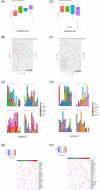Biogeographical variation in antimicrobial resistance in rivers is influenced by agriculture and is spread through bacteriophages
- PMID: 35799549
- PMCID: PMC9796506
- DOI: 10.1111/1462-2920.16122
Biogeographical variation in antimicrobial resistance in rivers is influenced by agriculture and is spread through bacteriophages
Abstract
Antibiotic resistance is currently an extensive medical challenge worldwide, with global numbers increasing steadily. Recent data have highlighted wastewater treatment plants as a reservoir of resistance genes. The impact of these findings for human health can best be summarized using a One Health concept. However, the molecular mechanisms impacting resistance spread have not been carefully evaluated. Bacterial viruses, that is bacteriophages, have recently been shown to be important mediators of bacterial resistance genes in environmental milieus and are transferrable to human pathogens. Herein, we investigated the biogeographical impact on resistance spread through river-borne bacteriophages using amplicon deep sequencing of the microbiota, absolute quantification of resistance genes using ddPCR, and phage induction capacity within wastewater. Microbial biodiversity of the rivers is significantly affected by river site, surrounding milieu and time of sampling. Furthermore, areas of land associated with agriculture had a significantly higher ability to induce bacteriophages carrying antibiotic resistance genes, indicating their impact on resistance spread. It is imperative that we continue to analyse global antibiotic resistance problem from a One Health perspective to gain novel insights into mechanisms of resistance spread.
© 2022 The Authors. Environmental Microbiology published by Society for Applied Microbiology and John Wiley & Sons Ltd.
Conflict of interest statement
The authors declare no competing financial interests.
Figures







References
-
- Anand, T. , Bera, B.C. , Vaid, R.K. , Barua, S. , Riyesh, T. , Virmani, N. et al. (2016) Abundance of antibiotic resistance genes in environmental bacteriophages. Journal of General Virology, 97, 3458–3466. - PubMed
-
- Bambic, D., McBride, G., Miller, W., Stott, R. & Wuertz, S. (2011) Quantification of pathogens and sources of microbial indicators for QMRA in recreational waters. In: Water intelligence online, Vol. 10. London, UK: IWA Publishing.
-
- Bouki, C. , Venieri, D. & Diamadopoulos, E. (2013) Detection and fate of antibiotic resistant bacteria in wastewater treatment plants: a review. Ecotoxicology and Environmental Safety, 91, 1–9. - PubMed
Publication types
MeSH terms
Substances
LinkOut - more resources
Full Text Sources

